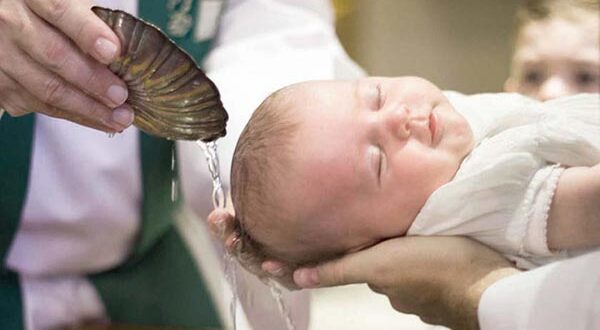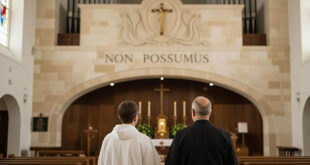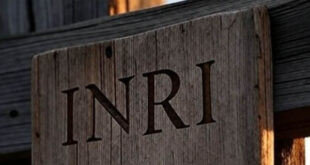At the heart of the Catholic faith lies a profound understanding of the struggle between good and evil, a spiritual battle that transcends the visible and delves into the deepest recesses of the human soul. It is within this context that the “minor exorcism,” a little-known but highly significant liturgical practice, finds its place, particularly in the sacrament of baptism. This article seeks to shed light on this ancient tradition, explain its theological meaning, and demonstrate why it remains relevant in today’s world.
What Is the Minor Exorcism?
The minor exorcism is a prayer of liberation used by the Church to ward off the influence of evil and prepare the soul to receive divine grace. Unlike the major exorcism, which is a solemn ritual reserved for extreme cases of demonic possession, the minor exorcism is a simpler and more common practice, integrated into certain sacraments and blessings.
In baptism, the minor exorcism plays a fundamental role. Through it, the Church acknowledges that original sin, the wound inherited from our first parents, Adam and Eve, has left a mark on the soul of the newborn. This sin is not a personal act of the child but a condition that separates them from the fullness of God’s grace. The minor exorcism, therefore, is an act of purification, a preparation for the baptized to receive the gift of new life in Christ.
The Minor Exorcism in the Rite of Baptism
The ritual of baptism, as we know it today, has evolved over the centuries, but its essence remains unchanged. In the traditional Roman rite, the minor exorcism is performed before the pouring of the baptismal water. The priest, in the name of Christ and the Church, pronounces words of liberation, such as:
“I exorcise you, unclean spirit, in the name of the Father, and of the Son, and of the Holy Spirit, that you may depart and flee from this servant of God. For He Himself commands you, accursed and damned spirit, He who walked upon the sea and extended His right hand to Peter as he sank.”
These words are not mere formalities but a proclamation of Christ’s victory over evil. The priest, acting in persona Christi, invokes the power of God to free the child from any diabolical influence and prepare them to become a temple of the Holy Spirit.
The Theological Meaning of the Minor Exorcism
The minor exorcism in baptism reminds us of a fundamental truth: evil exists, but Christ has conquered it. St. Paul expresses this clearly in his letter to the Romans: “Where sin increased, grace abounded all the more” (Romans 5:20). Original sin has deprived us of original holiness, but baptism restores us to divine life.
The minor exorcism is, therefore, an act of faith in Christ’s redemption. It is not a superstitious ritual but an affirmation that God’s power is stronger than any force of evil. By freeing the child from the influence of the devil, the Church introduces them into the family of God, where sin no longer reigns, but grace does.
Furthermore, this exorcism teaches us that the Christian life is a constant struggle. Baptism does not eliminate the possibility of sin, but it gives us the weapons necessary to resist evil. The minor exorcism, in this sense, is a reminder that we must always be vigilant, clothed in the armor of God (Ephesians 6:11).
Why Does the Church Practice It Today?
In an increasingly secularized world, where many question the existence of evil or reduce it to a mere psychological construct, the minor exorcism may seem outdated. However, its practice is more relevant than ever.
We live in a culture that, while denying sin, experiences its consequences: division, violence, despair. The minor exorcism reminds us that evil is not an illusion but a reality that must be confronted with the light of Christ. In baptism, the Church not only cleanses the soul of original sin but also strengthens it to resist the temptations of the world.
Moreover, the minor exorcism is an act of hope. By freeing the child from the influence of the devil, the Church proclaims that evil does not have the final word. Christ, the conqueror of sin and death, has given us the freedom of the children of God. Baptism is, therefore, a new beginning, a rebirth into eternal life.
The Minor Exorcism as a Spiritual Guide
The minor exorcism is not just a ritual for the newly baptized; it is also an invitation for all Christians to renew their commitment to Christ. Every time we make the sign of the cross, every time we invoke the name of Jesus, we are performing a small act of exorcism, rejecting evil and affirming our faith in God.
In a world full of distractions and temptations, we need to remember that the spiritual struggle is real. The minor exorcism teaches us that we are not alone in this battle. The Church, as a loving mother, offers us the tools necessary to resist evil and grow in holiness.
Conclusion: A Call to Freedom in Christ
The minor exorcism in baptism is much more than an ancient ritual; it is a powerful expression of the Church’s faith in the liberating power of Christ. It reminds us that, although evil exists, it has no power over those who have been redeemed by the blood of Jesus.
In a world that often seems dominated by darkness, the minor exorcism is a ray of hope. It reminds us that, through baptism, we have been freed from sin and called to live as children of the light. May this ancient practice inspire us to renew our faith, resist evil, and embrace the freedom that only Christ can offer.
Thus, the minor exorcism not only prepares the child for baptism but also invites all of us to live in the fullness of grace, trusting that, with Christ, we are more than conquerors.






